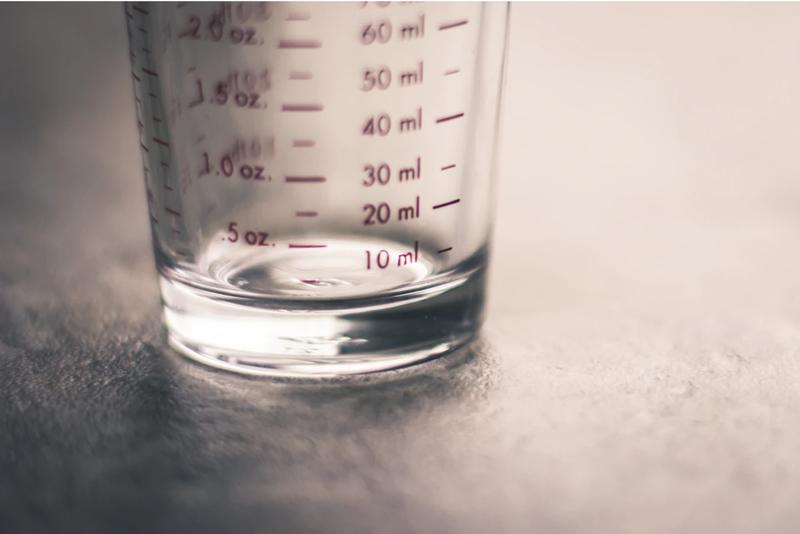How Much Beef Bouillon Makes a Cup of Broth

The cup, in United States customary units of measurement, holds 8 U.S. fluid ounces. If the U.S. fluid cup is equivalent to 8 fluid ounces, 2/3 of 8 fluid ounces is 5.28 U.S. fluid ounces. A cup in the British imperial system, on the other hand, holds 10 imperial fluid ounces. Two-thirds of 10 imperial fluid ounces is equivalent to 6.6 imperial fluid ounces. Most of the measurements in the U.S. customary and imperial systems are identical. However, there is a difference in the measurements of fluid volume between the two systems, even though both use the same names for the measurement units.
Fractions in Recipes
Visualizing fractions in recipe portions is easy for some but can pose a challenge for others. Fractions are equal to a part of a whole. Two-thirds or 2/3, for example, means that a whole is divided equally into 3 or "thirds" and the part of a whole measures 2 of the 3 equal portions.
Fractions are written with a top number referred to as the numerator and a bottom number called the denominator. Between these top and bottom numbers is a division line called a "vinculum."
Converting Fractions into Decimals
For some who are having trouble getting a mental picture of fractions in recipes, using a digital kitchen scale is one simple way of dealing with the issue. Since kitchen scales do not display fractions, you'll first have to convert the fractions into decimals. So how do you do it?
The "vinculum" or the division line sits between the numerator and denominator because fractions represent division. To get the decimal equivalent of a fraction, divide the numerator by the denominator, and the result will be the fraction in decimals. For example, 2/3 or 2 ÷ 3 gives you .66.
This makes it easier to calculate for the 2/3 or .66 portion of a cup in ounces. Since U.S. cups hold 8 ounces, multiply 8 by .66 to get the 2/3 portion of the cup in ounces. The same formula applies to the imperial system, where the imperial cup holds 10 ounces instead of 8.
US Customary vs. British Imperial Volume Measurements
Although the U.S. customary and imperial system units were derived from the English system, there is a slight difference in the fluid volume unit measurements between the two systems. Using the metric system for comparison, the following shows the differences:
- 1 U.S. customary fluid ounce = 29.573 milliliters
- 1 imperial fluid ounces = 28.413 mL
- 1 U.S. customary cup = 236.584 mL
- 1 imperial cup = 295.57 mL
- 1 U.S. pint = 473.176 mL
- 1 imperial pint = 568.261 mL
- 1 U.S. quart = 940 mL
- 1 imperial quart = 1,130 mL or 1.13 liters
- 1 U.S. gallon = 3,780 mL or 3.78 liters
- 1 imperial gallon = 4,540 mL or 4.54 liters
The U.S. customary pint holds 16 fluid ounces, while the imperial system pint holds 20 fluid ounces. Both these systems have quart measurements that hold 2 pints and gallon units that are equivalent to 4 quarts.
Is it US or Imperial?
One of the common issues encountered by those who are following recipes that they find online is figuring out whether the units that the recipe calls for are in U.S. customary or in the imperial system. One simple way to tell whether the measurements are in U.S. customary or imperial is to look for cup and gill measurements.
The British seldom use "cups" in recipe measurements, while Americans are largely unfamiliar with the "gill." It is also useful to note that recipes from the UK are usually weighed rather than measured with scoops.
Metric System Cup
Occasionally, some recipes may indicate a metric system cup. The metric system cup is exactly 250 mL, which is close to the U.S. customary cup. Two-thirds or .66 of the metric system cup is 164 mL, which is approximately 5.59 fluid ounces.
Source: https://www.reference.com/world-view/2-3-cup-ounces-10642f83d7c42d3e?utm_content=params%3Ao%3D740005%26ad%3DdirN%26qo%3DserpIndex
0 Response to "How Much Beef Bouillon Makes a Cup of Broth"
Post a Comment